Why explore asteroids, comets, and other small worlds
They're cosmic time capsules that provide a peek at our origin story.
Four and a half billion years ago, our solar system formed from a swirling disk of dust and gas orbiting the infant Sun. The Sun gobbled up most of the disk’s material, while cohesion and gravity pulled together clumps of rock, metal, and ice that eventually grew into planets. Generally speaking, asteroids, comets, and other small worlds are leftovers from that planet-building process.
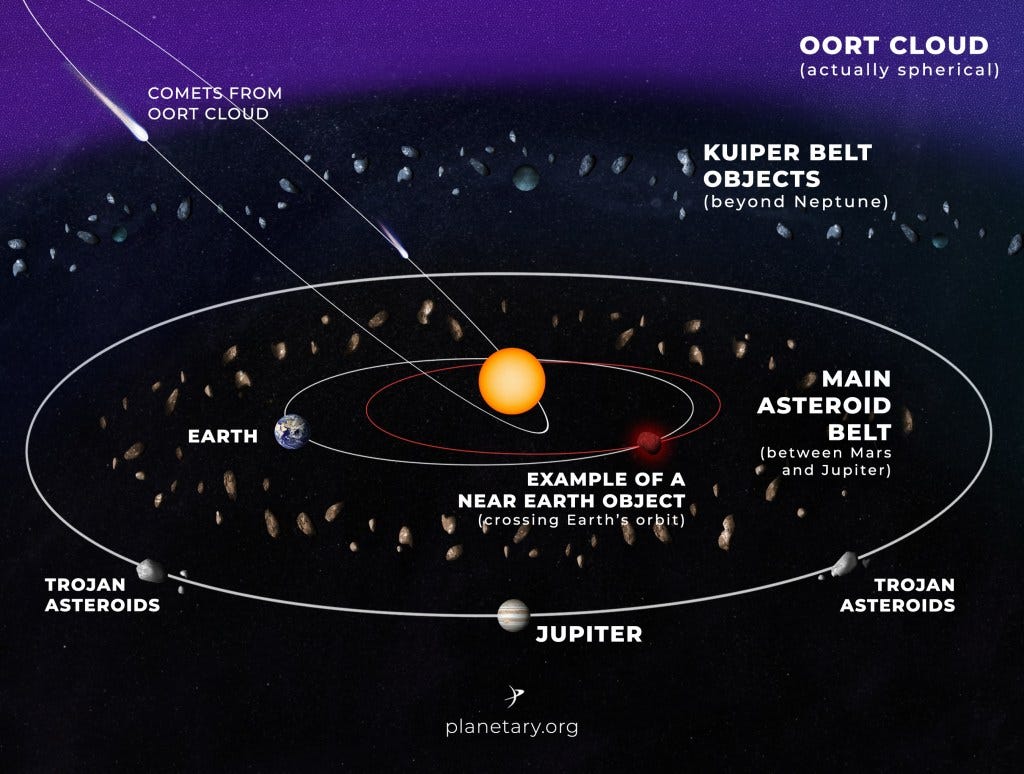
Why study small worlds?
On Earth, processes like weather and internal heating eliminate traces of the past. But physical changes in small worlds occur mostly due to external forces like solar radiation and impacts from other space rocks, making them time capsules that preserve information about the early solar system.
Mercury, Venus, Earth, and Mars were too hot in their early days for water and organic compounds necessary for life as we know it to stay on their surfaces. The materials that kickstarted life likely came from asteroids and comets that formed farther away from the Sun. Saturn and Jupiter probably formed closer to the Sun before jostling for position and migrating out to their current positions four billion years ago. In the process, the giant planets’ gravities scattered asteroids and comets all over the solar system. Some slammed into Earth and likely brought water and organics here, providing the precursors for life. By studying asteroids, comets, and other small worlds, we learn about where we come from and how the planets formed.
Asteroids
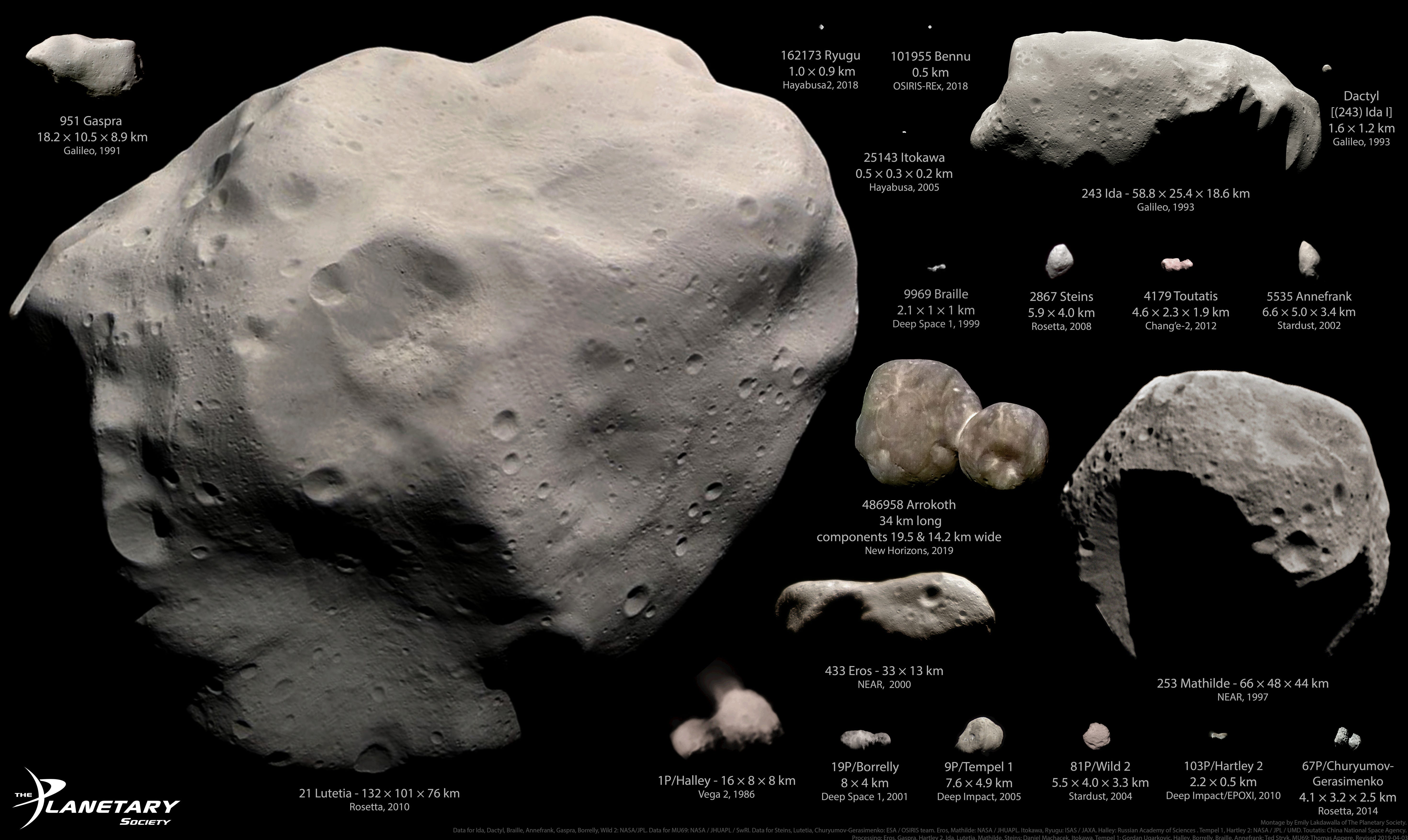
Asteroids are irregularly shaped objects ranging in size from a few meters to hundreds of kilometers across. Most are located in the asteroid belt between Mars and Jupiter, but some stray closer, like the near-Earth asteroids which lie within 1.3 astronomical units of the Sun (the Earth’s average distance to the Sun is 1 AU). If a near-Earth asteroid crosses Earth’s orbit and is bigger than 140 meters, it is considered a potentially hazardous object.
We thus study asteroids to prevent Earth from being hit by one. Asteroids are susceptible to small-scale forces like heat emission that change their orbits in ways we can’t always predict. Small worlds also come in a variety of densities, from loosely-bound clumps of boulders to tightly packed objects with planet-like cores. The strategy to deflect these different types of asteroids would be very different.
The resource-rich nature of asteroids make them potential places to power and expand human settlements in the solar system. Near-Earth asteroids go around the Sun in orbits similar to Earth’s, making them relatively easily accessible.
Comets
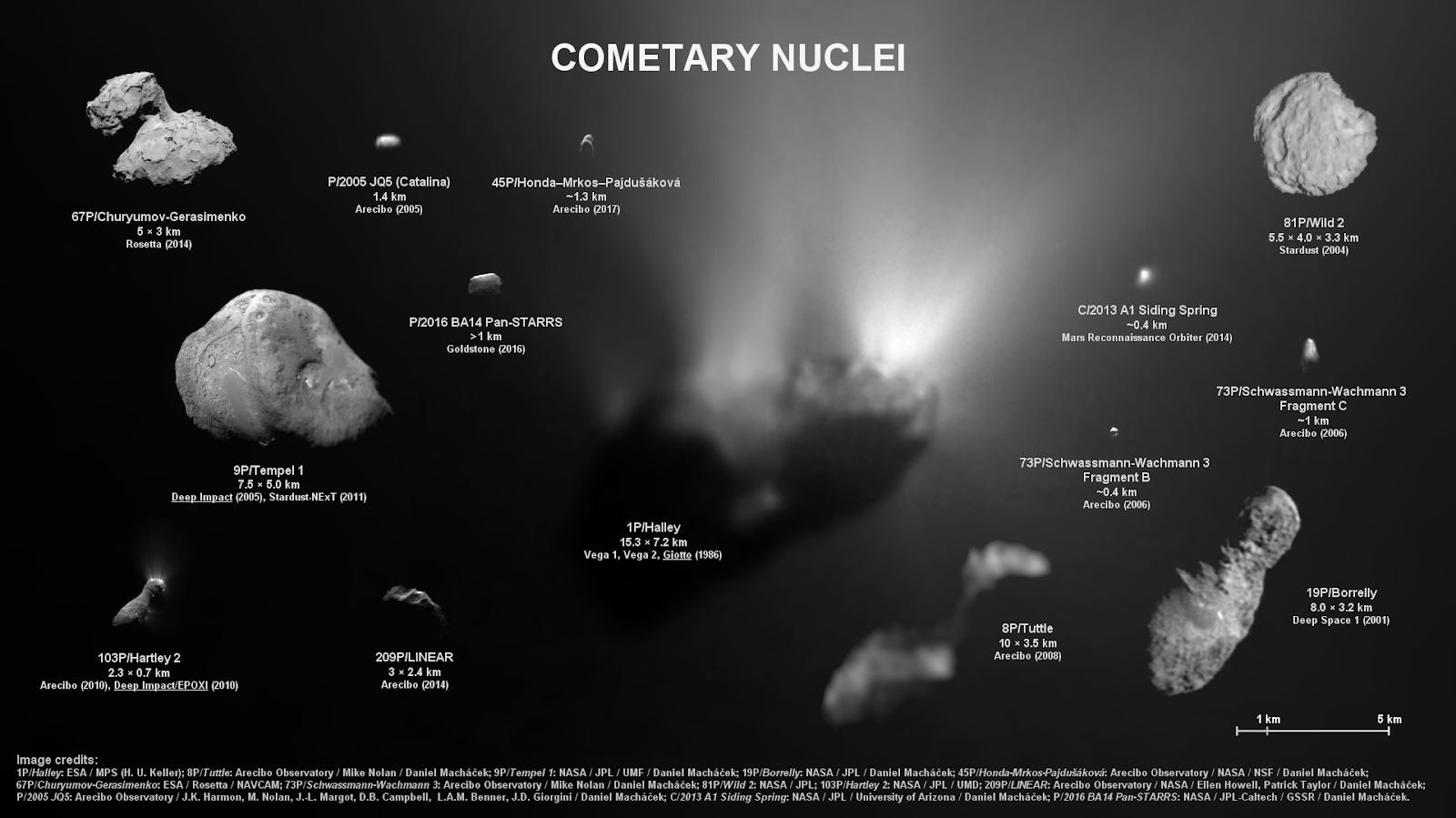
Comets are asteroid-like worlds that haven’t spent enough time in the inner solar system for the Sun to blast away their icy materials. Commonly referred to as dirty snowballs, they shed ice, dust, and gas as they approach the Sun, forming long, beautiful tails. Comets come from the Oort cloud, a sphere of objects 2000 AUs away that surrounds our solar system.
Some comets like Hyakutake, which passed Earth in 1996, have orbits that take tens of thousands of years to complete. Others have shorter periods, like Halley, which returns to the inner solar system every 75 years.
Comets leave a trail of dust behind as they pass through the inner solar system. If Earth passes through one of these trails, the particles slam into our atmosphere, creating a meteor shower! The annual Perseid meteor shower, which happens every August, is caused by debris from comet Swift-Tuttle, which last passed through the inner solar system in 1992 and won’t return for 133 years.
Kuiper Belt Objects (KBOs)
The Kuiper Belt, named after planetary scientist Gerard Kuiper, is a region of small worlds beyond Neptune’s orbit between 30 and 50 AU. Some KBOs like Eris and Pluto are large enough to be classified as dwarf planets by the International Astronomical Union. Such worlds are geologically rich, and larger than even the biggest asteroid belt object, Ceres, which itself is massive enough to be spherical, geologically active and be very much planet-like.
Other KBOs are more asteroid-like, such as Arrokoth, a lumpy, snowman-esque world visited by NASA’s New Horizons spacecraft in 2019. Unlike comets with elliptical orbits that take them close to the Sun repeatedly, such KBOs have circular orbits which haven’t been altered since their birth 4.5 billion years ago. Further, their great distance means solar heat and radiation have minimal effects on their surface. KBOs are also spared of the frequent impacts faced by objects in the denser, inner solar system. These facts make KBOs among the pristine targets of interest in the solar system.
A brief history of exploration of the small worlds
Because small worlds are scattered all over the solar system, we use different approaches to explore them. Asteroids—in particular, near-Earth asteroids—are relatively easy to reach with a spacecraft, but their low gravities make orbiting them a challenge. Many asteroids are close enough for us to image with Earth-based radar, which helps us figure out their shapes.
Comets fly through the inner solar system at a variety of angles. Halley’s comet, for instance, enters the inner solar system clockwise, from beneath our orbital plane. This means a spacecraft trying to rendezvous with the comet must cancel out Earth’s counter-clockwise momentum, pick up speed in the opposite direction, and tilt the plane of its orbit significantly. This requires significant amounts of fuel, which is why solar sail missions have been proposed for reaching certain comets.
The Oort cloud is too distant to visit for now, but the Kuiper Belt is within reach—providing you have some extra time on your hands. New Horizons was the fastest object to ever leave Earth at the time of its launch, and still took nine years to reach Pluto.
Exploring asteroids
NASA’s Jupiter-bound Galileo spacecraft made the first asteroid flyby in 1991, coming within 1600 kilometers of Gaspra in the main asteroid belt. The pictures revealed an irregularly shaped world formed by debris from a collision between other objects. Two years later in 1993, Galileo gave us a close look at another main belt asteroid, Ida, which turned out to have a tiny moon now named Dactyl.
NASA’s NEAR Shoemaker spacecraft entered orbit around near-Earth asteroid Eros in 2000 and later touched down on its surface—both firsts for any spacecraft. The agency in 2007 launched the Dawn spacecraft to orbit Vesta and then Ceres, the two largest worlds in the main asteroid belt. Under the IAU’s planet classification system, Vesta is an asteroid and Ceres is a dwarf planet.
Dawn found water-bearing minerals on Vesta’s surface and abundant water ice and organics on Ceres. Because these materials evaporate close to the Sun, Vesta and Ceres either formed farther away or were struck by objects carrying water and organics that formed farther away. Ceres has hundreds of bright spots formed by briny (salty) water bubbling up from a subsurface reservoir. While icy moons like Enceladus and Europa have subsurface oceans that are warmed by the pull of nearby giant planets, Ceres appears to have enough internal heat to keep its subsurface water from freezing.
Sampling asteroids
Before being able to build spacecraft to sample asteroids, meteorites found in Antarctica were the only way to study them. While free space rocks on Earth are great, they become altered by exposure to Earth’s atmosphere and life forms, losing their original state, and we don’t know where they came from, limiting our ability to draw firm conclusions.
In 2010, Japan’s Hayabusa spacecraft returned samples from Itokawa, a peanut-shaped near-Earth asteroid a half-kilometer long. Water found in the samples was remarkably similar to that of Earth’s oceans, indicating much of our water could have come from similar asteroids.
Sample return missions from two more near Earth asteroids are in progress. Hayabusa2 is on its way back to Earth now with samples from the diamond-shaped, rubble-pile asteroid Ryugu, while NASA’s OSIRIS-REx spacecraft is preparing to collect samples from a similar asteroid Bennu.

Why do we need sample return?
It may seem like a lot of trouble to fly all the way to another world just to bring a few handfuls of rock and soil back to Earth. But certain questions can only be answered by tools that are too large, heavy, and power-hungry to fly on spacecraft. Sample return is particularly important for:
Precision: Space-based instruments can’t tell us the date of a sample as accurately as Earth-based instruments can.
Reproducibility: On Earth, we can double-check our results with multiple instruments. That’s particularly important when those results could be something as astonishing as detecting life on another object.
Duration: Technology improves over time, so storing samples on Earth allows future generations to run newer, better experiments.
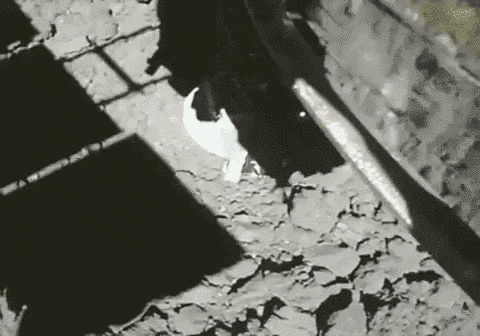
Once returned to Earth, Ryugu and Bennu samples will be analyzed using state-of-the-art laboratories for years. NASA and the Japanese Space Agency have an agreement to trade samples with each other. Studying the samples will teach us how dynamic the early solar system was and how exactly it evolved. Organic materials and water-bearing minerals in the samples, known to be present from orbital mapping of these asteroids, will also tell us about the nature of chemistry in the early solar system, and how much of Earth’s water and organics were delivered by such asteroids.
Exploring comets
In 1985, NASA’s International Cometary Explorer, ICE, became the first spacecraft to fly past a comet, coming within 7,900 kilometers of comet Giacobini-Zinner. Although ICE had no cameras, it detected water and carbon monoxide, confirming the theory that comets are similar to dirty snowballs.
A year later, a fleet of international spacecraft flew past Halley’s comet, including Europe’s Giotto spacecraft, which captured images of a comet’s nucleus for the very first time. The pictures revealed a potato-shaped world 16 kilometers long tumbling through space, spewing jets of dust, gas, and ice.
NASA’s Stardust probe flew past comet Wild 2 in 2004, collecting samples of dust and returning them to Earth for the very first time. In the samples scientists found amino acids, organic chemicals that are part of the building blocks of life. In 2005, NASA’s Deep Impact spacecraft shot a 364-kilogram impactor into comet Tempel 1, kicking up fluffy dust that helped scientists understand what lies beneath cometary surfaces.
The European Space Agency’s Rosetta mission, launched in 2004, orbited and dropped a lander on comet 67P/Churyumov-Gerasimenko as the comet flew through the inner solar system, giving us an unprecedented look at how comets change over time.
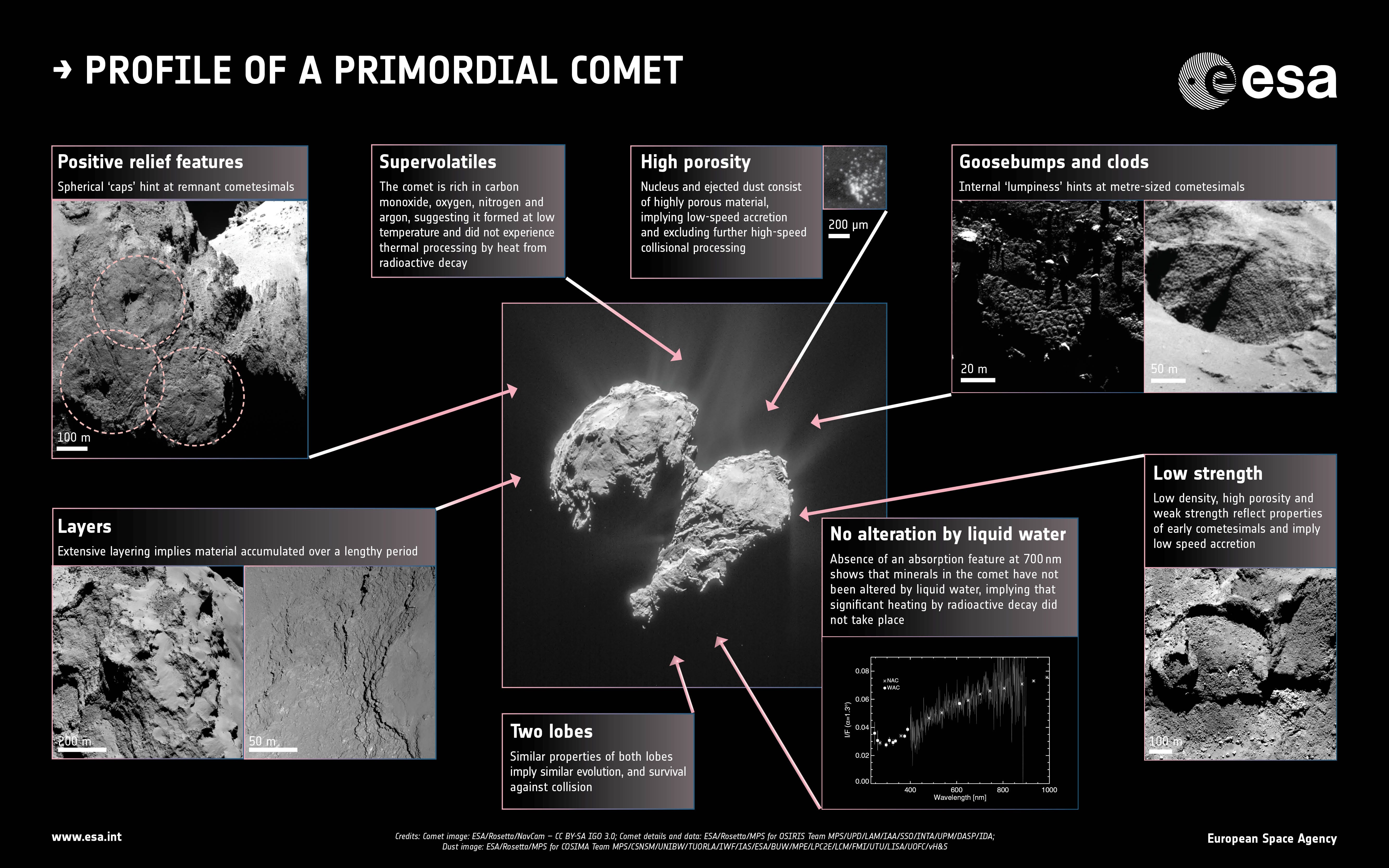
Rosetta found comet 67P’s water to be different from Earth’s and even to that of many other comets and asteroids, indicating diverse origins of water in our solar system.
Exploring the Kuiper Belt
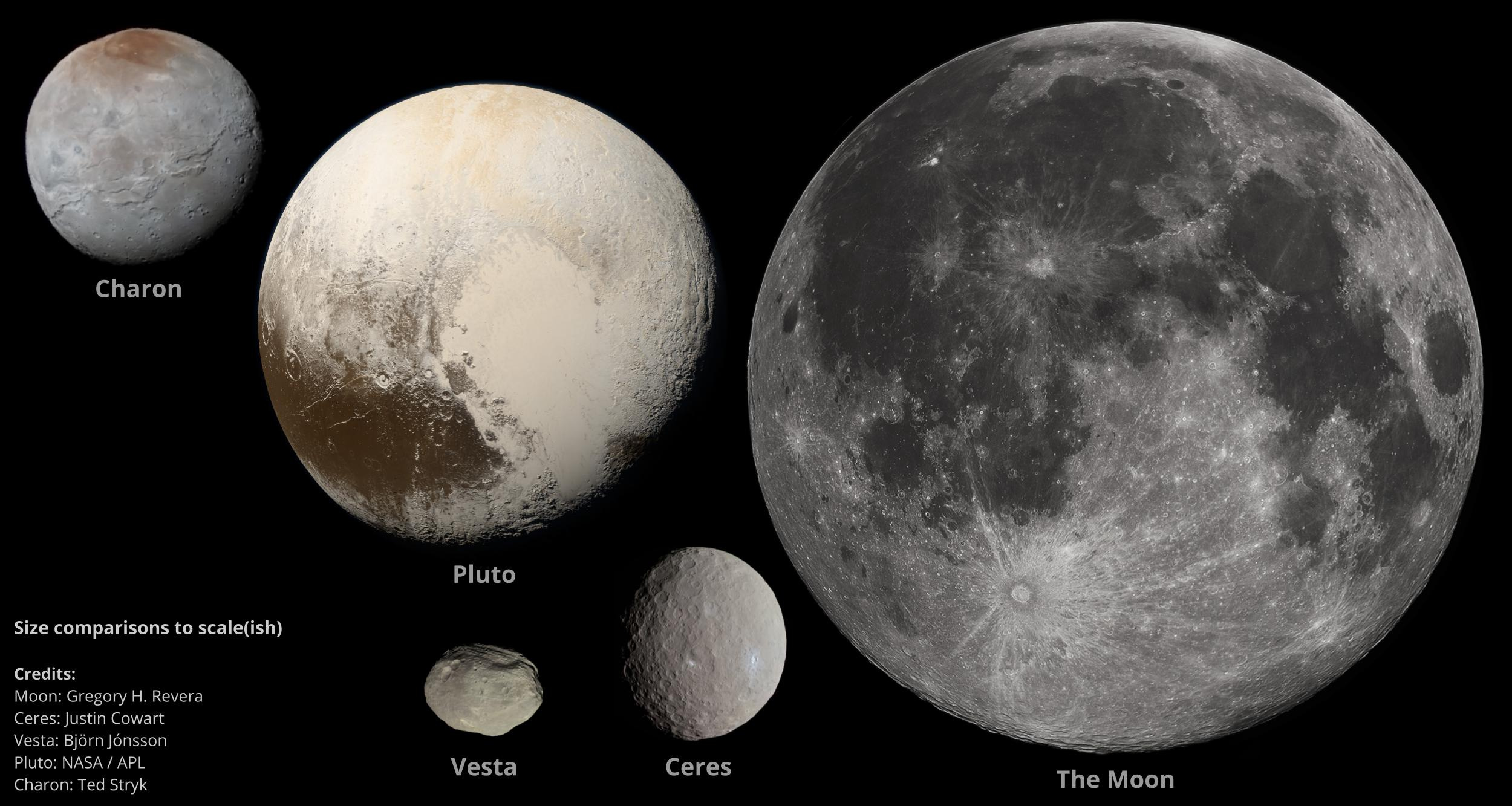
NASA’s New Horizons is the only spacecraft to explore the Kuiper Belt. It flew past Pluto in 2015 and revealed a planet-like world with its mountains, glaciers, and a frozen “heart” of solid nitrogen ice—all indicators of recent geological activity. Scientists also saw hints that Pluto may harbor a subsurface liquid water ocean. Even Pluto’s moon Charon turned out to have remarkably varied landforms.
With New Horizons still in great shape, scientists using the Hubble Space Telescope found another KBO in New Horizons’ neighborhood to visit that we now call Arrokoth.
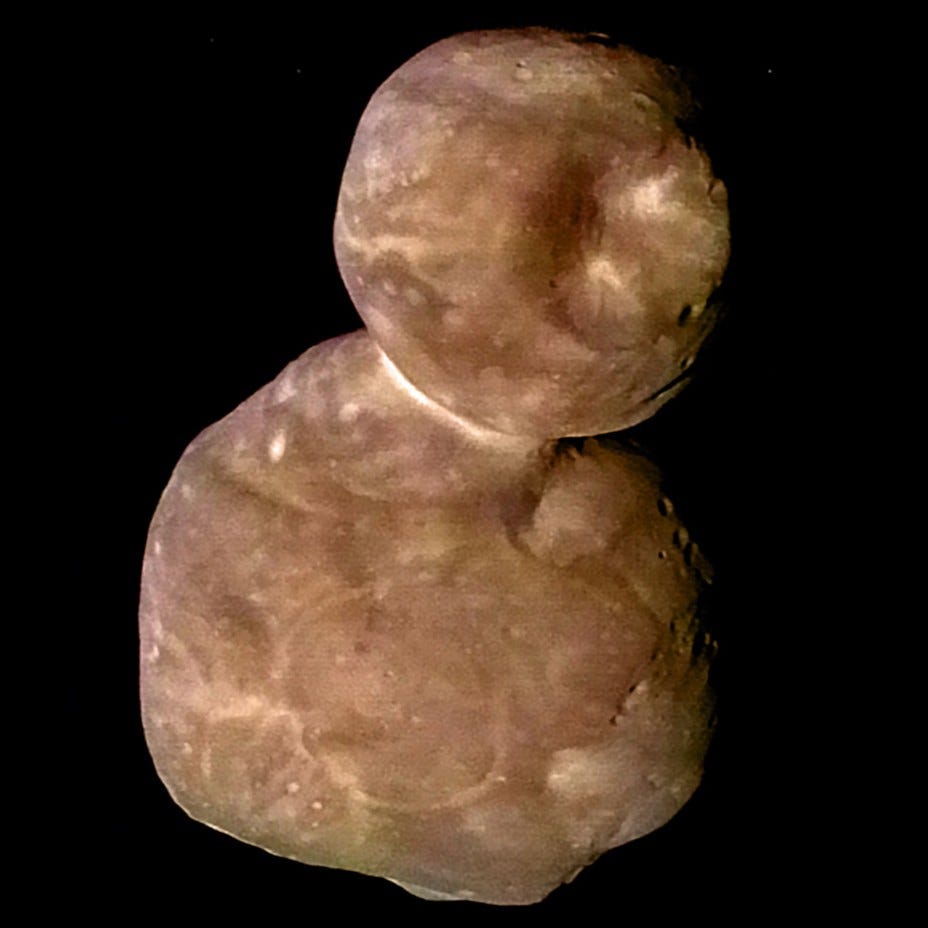
The spacecraft flew past Arrokoth in 2019 and found a 35-kilometer-long world likely among the most primitive, unaltered objects in our solar system. Arrokoth’s two lobes look like they formed due to a slow-speed collision, contradicting the notion that small worlds are prone to chaotic, high-speed smashups.
New Horizons is still flying through the Kuiper Belt on its way out of our solar system, observing and studying other objects from afar while scientists look for another potential flyby target.
Future missions
Several exciting missions are planned in the next ten years to explore uncharted small worlds and get answers to many of the remaining fundamental questions of our solar system’s past.
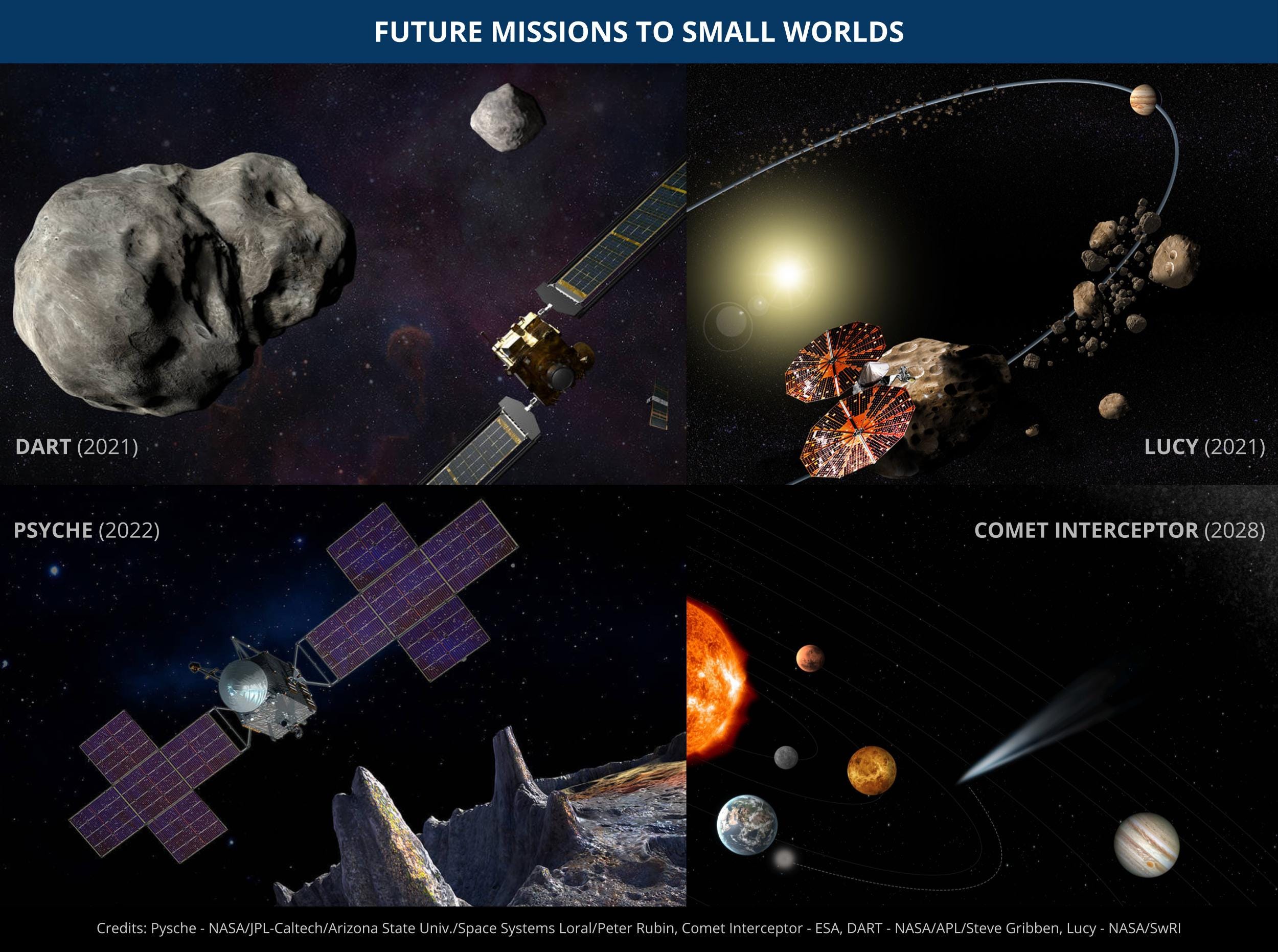
A NASA mission called Lucy launched in October 2021 to visit 7 of Jupiter’s Trojan asteroids for the very first time. They are two clumps of asteroids that share Jupiter’s orbit around the Sun. Jupiter’s journey in the early solar system to its present location must be imprinted in the diverse Trojans as they moved along with Jupier, giving us a chance to figure out what really happened.
The agency’s Psyche spacecraft will launch in 2022 and arrive at the same-named, main-belt asteroid Psyche in 2026. Scientists think 220-kilometer-wide Psyche is an exposed iron-nickel core of a small world that formed early in our solar system’s history but never reached planetary size. Studying it will give us unique insights about how the planets formed.
In 2021, NASA launched DART, the Double Asteroid Redirection Test. DART will deliberately crash itself into asteroid Didymos’ small moon, Dimorphos, to change the moon’s orbital speed. Astronomers on Earth will measure this change to determine whether such a technique could be used to deflect an asteroid predicted to hit our planet.
All previous comet missions have studied comets with relatively short orbital periods. ESA’s Comet Interceptor mission, scheduled to launch in 2028, hopes to give us our first close look at a very long-period comet, a pristine object that has entered the inner solar system only a few times. Comet Interceptor will lie in wait at a stable spot in space called L2 where the Sun and Earth’s gravity balance out. When astronomers discover an interesting long-period comet heading through the inner solar system, Comet Interceptor will travel to it, splitting into 3 separate spacecraft during close approach for multi-point observations.
Our goal to unravel the solar system’s past along with our increasing technological abilities is leading us to more and more pristine objects in the solar system. These ‘non-planets’ scattered across our solar system hold clues to the system’s origin and how life on Earth got its necessary ingredients.
Originally published at The Planetary Society.
Like what you read? Support me to keep me going.
